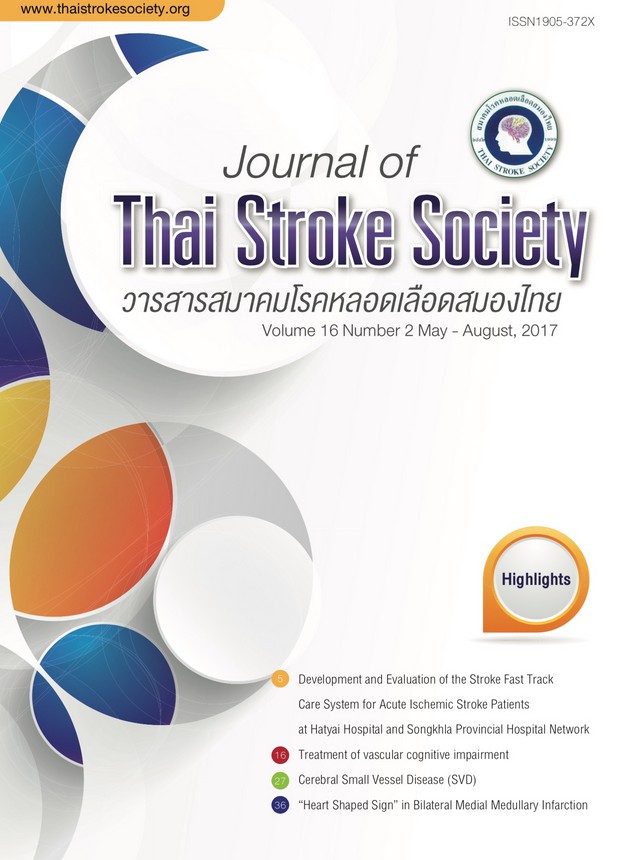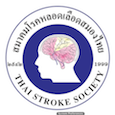Cerebral Small Vessel Disease (SVD)
Keywords:
cerebral small vessel disease, lacunar infarction, white matter hyperintensities, microbleedAbstract
Cerebral small vessel disease is the pathological process that affects small vessels of brain, including small arteries, arterioles, capillaries, small veins and small venules. There are 2 main types of pathological features: type 1, arteriolosclerosis, and type 2, cerebral amyloid angiopathy. The consequences of small vessel disease on the brain parenchyma are heterogeneous as various findings on neuroimages including lacunar infarction, white matter hyperintensities, enlarged perivascular space, and cerebral microbleed. Aim of treatment is controlling risk factors especially hypertension. However risk of bleeding is increased, so antithrombotic treatment should be carefully considered among these patients.
References
Debette S, Markus HS. The clinical importance of white matter hyperintensities on brain magnetic resonance imaging: systemic review and meta-analysis. BMJ 2010; 341: 3666.
Gorelick PB, Scuteri A, Black SE, et al. Vascular contributions to cognitive impairment and dementia: a statement for healthcare professional from the American Heart Association / American Stroke Association. Stroke 2011; 42: 2672-713.
Pantoni L. Cerebral small vessel disease: from pathogenesis and clinical characteristics to therapeutic challenges. Lancet Neurol 2010; 9: 689-701.
Joanna MW, Colin S, Martin D. Mechanism of sporadic cerebral small vessel disease: insights from neuroimaging. Lancet Neurol 2013; 12: 483-97.
Moody DM, Brown WR, Challar VR, et al. Periventricular venous collagenosis: association with leukoariosis. Radiology 1995; 194: 469-76.
Furuta A, Nobuyoshi N, Nishihara Y, et al. Medullary arteries in aging and dementia. Stroke1991; 22: 442-46.
Andreas C, David JW. Cerebral microbleeds: detection, mechanisms and clinical challenges. Future Neurol 2011; 6(5), 587-611.
Masahito Y. Cerebral amyloid angiopathy: Emerging concepts. Journal of stroke 2015; 17(1): 17-30.
Louis RC. Lacunar infarction and small vessel disease: Pathology and Pathophysiology. Journal of stroke 2015; 17(1): 2-6.
Donnan GA, Bladin PF, Berkovic SF, et al. The stroke syndrome of striatocpsular infarction. Brain 1991; 114: 51-70.
Vincent M, Jong SK. Prevention and management of small vessel disease. Journal of stroke 2015; 17(2): 111-122.
Joanna MW, Eric ES, Geert B, et al. Neuroimaging standards for research into small vessel disease and its contribution to ageing and neurodegeneration. Lancet Neurol 2013; 12: 822-38.
van Dijk EJ, Breteler MM, Schmidt R, et al. The association between blood pressure, hypertension, and cerebral white matter lesions: cardiovascular determinants of dementia study. Hypertension 2004: 44: 625-630.
Bakker SL, de Leeuw FE, de Groot JC, et al. Cerebral vasomotor reactivity and cerebral white matter lesions in the elderly. Neurology 1999; 52: 578-583.
Longstreth WT Jr, Arnold AM, Beauchamp NJ Jr, et al. Incidence, manifestation, and predictors of worsening white matter on serial cranial magnetic resonance imaging in elderly: The Cardiovascular Health Study. Stroke 2005; 36: 56-61.
Xiong Y, Wong A, Cavalieri M, et al. Prestroke statins, progression of white matter hyperintewnsity, and cognitive decline in stroke patients with confluent white matter hyperintensities. Neurotherapeutics 2014; 11: 606-611.
O’Brien JT, Erkinjuntti T, Reisberg B, et al. Vascular cognitive impairment. Lancet Neurol 2003; 2: 89–98.
Koga H, Takashima Y, Murakawa R, et al. Cognitive consequences of multiple lacunes and leukoaraiosis as vascular cognitive impairment in community-dwelling elderly individuals. J Stroke Cerebrovasc Dis 2009; 18: 32–37.
Vermeer, SE, Prins MD, Heijer T, et al. Silent brain infarcts and the risk of dementia and cognitive decline. N Engl J Med 2003; 348: 1215–22.
Pantoni L. Leukoaraiosis: from an ancient term to an actual marker of poor prognosis. Stroke 2008; 39: 1401–03.
Ferro JM, Madureira S. Age-related white matter changes and cognitive impairment. J Neurol Sci 2002; 203–204: 221–25.
Jokinen H, Kalska H, Ylikoski R, et al, for the LADIS group. Longitudinal cognitive decline in subcortical ischemic vascular disease--the LADIS study. Cerebrovasc Dis 2009; 27: 384–91.
Rosano C, Brach J, Longstreth Jr WT, et al. Quantitative measures of gait characteristics indicate prevalence of underlying subclinical structural brain abnormalities in high-functioning older adults. Neuroepidemiology 2006, 26(1): 52-60.
Sibon I, Fenelon G, Quinn NP, et al. Vascular parkinsonism. J Neurol 2004, 251(5): 513-524.
Srikanth V, Beare R, Blizzard L, et al. Cerebral white matter lesions, gait, and the risk of incident falls: a prospective population-based study. Stroke 2009, 40(1): 175-180.
Ryuji Sakakibara, Jalesh Panicker, Clare J Fowler, et al. Vascular incontinence: incontinence in the elderly due to ischemic white matter changes. Neurol Int. 2012 Jun 14; 4(2): e13.
Rebecca L. Brookes, Vanessa Herbert, Andrew J. Lawrence, et al. Depression in small-vessel disease relates to white matter ultrastructural damage, not disability. Neurology. 2014 Oct 14; 83(16): 1417–1423.
Howard J. Aizenstein, Andrius Baskys, Maura Boldrini, et al. Vascular depression consensus report – a critical update. BMC Med. 2016; 14: 161.
Palumbo V, Boulanger JM, Hill MD, et al, for the CASES Investigators. Leukoaraiosis and intracerebral hemorrhage after thrombolysis in acute stroke. Neurology 2007; 68: 1020–24.
Dannenberg S, Scheitz JF, Rozanski M, et al. Number of cerebral microbleeds and risk of intracerebral hemorrhage after intravenous thrombolysis. Stroke 2014; 45:2900-2905.
Benavente OR, Hart RG, McClure LA, et al. Effects of clopidogrel added to aspirin in patients with recent lacunar stroke. N Engl J Med 2012; 367: 817-825.
Uchiyama S, Shinohara Y, Katayama Y, et al. Benefit of cilostazol in patients with high risk of bleeding: subanalysis of cilostazol stroke prevention study 2. Cerebrovasc Dis 2014;37: 296-303.
Pergola PE, White CL, Graves JW, et al, for the SPS3 Investigators. Reliability and validity of blood pressure measurement in the Secondary
Prevention of Small Subcortical Strokes study. Blood Press Monit 2007; 12: 1-8.
Majon M, Sigurdur S, Olafur K, et al. Joint effect of mid- and late-life blood pressure on the brain; The AGES-Reykjavik Study. Neurology 2014; 82:
2187–2195
Amarenco P, Benavente O, Goldstein LB, et al, for the SPARCL Investigators. Results of the Stroke Prevention by Aggressive Reduction in Cholesterol Levels (SPARCL) trial by stroke subtypes. Stroke 2009; 40: 1405–09.
Mok VC, Lam WW, Fan YH, et al. Effects of statins on the progression of cerebral white matter lesion: post hoc analysis of the ROCAS (Regression of Cerebral Artery Stenosis) study. J Neurol 2009; 256: 750–57
Downloads
Published
How to Cite
Issue
Section
License
ข้อความภายในบทความที่ตีพิมพ์ในวารสารสมาคมโรคหลอดเลือดสมองไทยเล่มนี้ ตลอดจนความรับผิดชอบด้านเนื้อหาและการตรวจร่างบทความเป็นของผู้นิพนธ์ ไม่เกี่ยวข้องกับกองบรรณาธิการแต่อย่างใด การนำเนื้อหา ข้อความหรือข้อคิดเห็นของบทความไปเผยแพร่ ต้องได้รับอนุญาตจากกองบรรณาธิการอย่างเป็นลายลักษณ์อักษร ผลงานที่ได้รับการตีพิมพ์ในวารสารเล่มนี้ถือเป็นลิขสิทธิ์ของวารสาร





